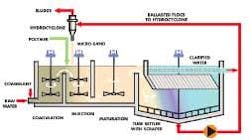Microsand Clarification Process Provides Improved Treatment for "Difficult" Waters
The first I. Kruger Actiflo® high rate microsand enhanced clarification process was installed in 1998 at North Table Mountain, CO, to treat 11 MGD. Since then, the process has been installed (or being installed) in over 90 plants in the domestic US market treating a total of over 1 billion gallons per day.
The Actiflo Process combines conventional coagulation/flocculation chemistry with inorganic silica microsand to provide a high rate clarification Process.
Fundamentally, the process is very similar to conventional coagulation, flocculation and sedimentation water treatment technology. Both processes use coagulant for the destabilization, and flocculant aid polymer for the aggregation of suspended materials. These materials are then subsequently removed by settling for disposal.
The Actiflo differs from conventional clarification in that it provides microsand as a ballasting agent in the flocculation process step. The microsand serves several important roles in the process:
• The high specific surface area to volume ratio of the microsand particles serves as a "seed" for floc formation;
• The microsand and polymer "seed" promote the enmeshment of suspended materials and result in the formation of large stable floc;
• The relatively high specific gravity of the microsand (~2.65) serves as a ballast for the formation of high-density floc;
• The high microsand concentration within the process dampens the effects of changes in the raw water quality;
•The chemically inert microsand does not react with the process chemistry, allowing it to be removed from chemical sludge and reused in the process.
Together, these factors provide a process that is efficient in the treatment of "difficult" waters, stable with changes in raw water quality, and relatively easy to operate and optimize.
Overall, the use of microsand results in the development of chemical floc that is significantly dense and more durable than floc from a conventional clarification processes. These flocs have considerably higher settling velocities than conventional flocs and allow significantly higher clarifier overflow rates. The higher overflow rates translate directly into reduced process volume, reduced system footprint, and significant reductions in total civil cost.
The rapid efficient mixing in the Actiflo process has the added benefit of improved coagulant and polymer utilization, which in many instanced yields reduced operation cost when compared to conventional clarification processes. Depending upon plant flows and raw water conditions, some plants have reported annual chemical cost savings of from $80,000 to $400,000 per year.
Improvements in clarification performance have also led to increased filter volumes, thereby reducing filter backwash cycles, backwash volumes and reduced pumping and backwash costs.
Applications
Applications for the Actiflo Process continue to grow. In addition to clarification prior to conventional gravity filtration the process has been successfully applied to membrane pre treatment and filter backwash recovery.
The process is used for pre treatment prior to membrane micro filtration at drinking water plants are operating at Maryville, MO, and Cass County, MO. A new pre treatment facility at the City of Clovis, CA, is expected to be operational in the summer of 2004. This plant will be comprised of 2 x 7.5 mgd trains of Actiflo.
Numerous pilot studies have been run to demonstrate the suitability of the Actiflo process for treating filter backwash. The first full scale FBW plant came on line in 2003 at Rancho Santa Fe Springs, CA, with a design capacity of 4 mgd.
Stability and flexibility are two key operational benefits of the Actiflo Process. The process has proven to be an excellent clarification process in a variety of difficult and demanding surface water treatment applications.
TOC Removal — The Actiflo Process is being used in many plants across the country to comply with the ESWTR. While TOC removal performance is driven by the regulations combining raw water TOC concentration and raw water alkalinity, it is not unusual to see TOC removals of 40 to 50%. The process has demonstrated TOC reduction from 20mg/l to 3 through just the clarification step.
Turbidity Spikes — In several full scale applications on flashy surface waters, the ACTIFLO Process has dealt with variations in raw water turbidity from an average of daily turbidity of 6 NTU to a peak of 1000 NTU. Throughout this the process settled water quality remained steady, leading to filtered water quality consistently meeting treatment guidelines.
Seasonal Variations — One of the most challenging applications has been that of treating surface water in central Florida. Seasonal variations in raw water conditions can be quite extreme. In one Actiflo plant the seasonal variations are characterized by a "dry season" and a "wet season."
During the "dry season" the raw water quality entering the system has a turbidity of 2 to 4 NTU, color of 25 to 50 PCU unfiltered color units, organics loading of 4 to 8 mg/l total organic carbon (TOC) and 100 to 150 mg/l alkalinity as CaCO3. During the wet season, the raw water has a turbidity of 2 to 4 NTU; color of 200 to 350 PCU unfiltered color, organic loading up to 28 mg/l TOC and 30 to 80 mg/l alkalinity as CaCO3.
The Actiflo Process has met its process guarantees and commitments and continues to improve in performance as plant personnel gain experience in operating the process plant under these challenging raw water conditions.

